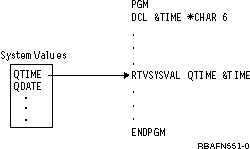This gives an overview of the types of operations performed using CL procedures
In general, you can:

- Use variables, logic control commands, expressions, and built-in functions
to manipulate and process data within a CL procedure:
PGM DCL &C *LGL DCL &A *DEC VALUE(22) DCL &B *CHAR VALUE(ABCDE) • • • CHGVAR &A (&A + 30) • • • IF (&A < 50) THEN(CHGVAR &C '1') • DSPLIB ('Q' ∨∨ &B) • IF (%SST(&B 5 1)=E) THEN(CHGVAR &A 12) • • • ENDPGM - Use a system value as a variable in a CL procedure.

- Use a job attribute as a variable in a CL procedure.

- Send and receive data to and from a display file with a CL procedure.

- Create a CL procedure to monitor error messages for a job, and take corrective
action if necessary.
PGM MONMSG MSGID(CPF0001) EXEC(GOTO ERROR) CALL PROGA CALL PROGB RETURN ERROR: SNDPGMMSG MSG('A CALL command failed') MSGTYPE(*ESCAPE) ENDPGM - Control processing among procedures and programs and pass parameters from a CL procedure to other procedures or programs to override files.

Used as a controlling procedure, a CL procedure can call procedures written in other languages. The preceding illustration shows how control can be passed between a CL procedure and RPG IV* and ILE COBOL procedures in an application. To use the application, a workstation user would request program A, which controls the entire application. The illustration shows a single bound program (PGMA) that is called using the CALL command with PGMA. PGMA consists of:
- A CL procedure (PGMA) calling an RPG IV procedure (PGMB)
- An RPG IV procedure (PGMB) calling another RPG IV procedure (PGMC)
- An RPG IV procedure (PGMB) calling a CL procedure (PGMD)
- A CL procedure (PGMA) calling an ILE COBOL procedure (PGME)
- An ILE COBOL procedure (PGME) calling a CL procedure (PGMF)

The procedures can be created as indicated in the following example. You can enter source for procedures in separate source members.
CRTCLMOD PGMA
CRTRPGMOD PGMB
CRTRPGMOD PGMC
CRTCLMOD PGMD
CRTCBLMOD PGME
CRTCLMOD PGMF
CRTPGM PGM(PGMA) +
MODULE(PGMA PGMB PGMC PGMD PGME PGMF) +
ENTMOD(*FIRST)